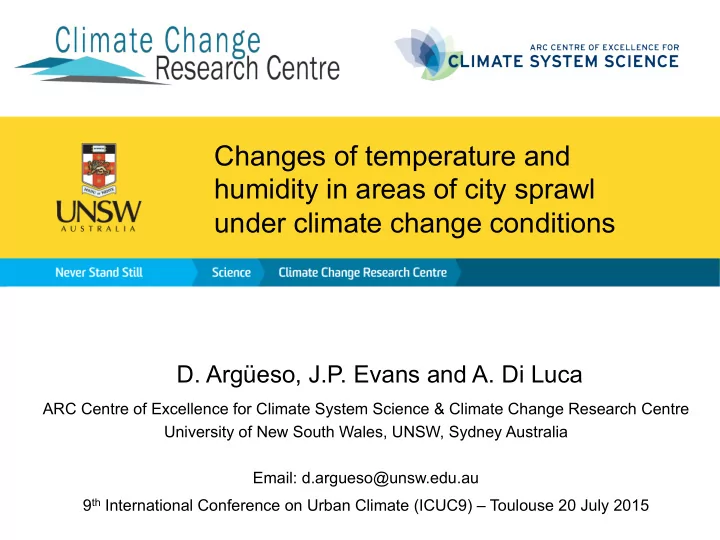

Changes of temperature and humidity in areas of city sprawl under climate change conditions D. Argüeso, J.P. Evans and A. Di Luca ARC Centre of Excellence for Climate System Science & Climate Change Research Centre University of New South Wales, UNSW, Sydney Australia Email: d.argueso@unsw.edu.au 9 th International Conference on Urban Climate (ICUC9) – Toulouse 20 July 2015
Motivation FACTORS Climate in cities is distinct Urban Anthropogenic population climate change growth (urbanization) QUESTION What will be the ? combined effect of CC and urban expansion?
Future climate at urban scales GCM (150-200km) RCM (10km) • GCM primary source of Climate Change information • But too coarse to represent cities • RCMs at 10k capture some features of the city, but urban areas are represented only Sydney as different land use • Need for explicit representation of No cities at all Only urban land use cities!
Future climate at urban scales GCM (150-200km) RCM (10km) RCM (2km) Sydney No cities at all Only urban land use Urban canopy model
Experiment design • Weather Research and Forecasting (WRF) system • 2-km spatial resolution (nested in 10k and 50k) – CSIRO-MK3.5 • No cumulus parameterization in inner domain (explicit) • Using Urban Canopy Model (SLUCM) 1 Sun Z Wind profile Fluxes Radiation Roughness sublayer Lowest model level Urban canopy layer Momentum SLUCM Source: (2) Chen et al. (2011) (1) Kusaka et al. (2001) Boundary-Layer Meteorology
Experiment design • Three 20-y simulations: – 1990-2009: Present climate, present LU (CO) – 2040-2059: Future climate, present LU (CC) – 2040-2059: Future climate, future LU (CC + URB) • Climate change (A2) + Urban expansion (red)
Temperature and humidity climatology Day Night Elevation Temperature Land use Vapor Pressure (3) Argüeso et al. (2015) PLoS ONE
Changes in temperature Day Night CC only • Tmax changes:~ 1.0 to 1.5°C • Tmin changes: ~ 1.5 to over CC 2.0°C CC + URB: • Tmax changes: similar to CC only • Tmin changes: ~ 3.0 to over 4.0°C (LU change) • Almost no footprint of urban CC + URB expansion in Tmax • Clear impact of urban expansion on Tmin (2) Argüeso et al. (2014) Clim Dyn
Changes in humidity (vapor pressure) Day Night Overall increase in VP due to global warming CC But substantially smaller increases in new urban areas, particularly during the day CC + URB (3) Argüeso et al. (2015) PLoS ONE
Changes in heat stress Day Night • Heat stress: simplified wet-bulb globe temperature • W = 0.567*T+0.393e+3.94 CC CC + URB (3) Argüeso et al. (2015) PLoS ONE
Conclusions • Urban expansion + Climate change using RCMs: – City growth effect on local Tmin ~ climate change signal (A2) – No perceptible impact on Tmax changes – Reduced diurnal cycle • Smaller increases in humidity (vapor pressure) – Less than half of the CC-only increase during the day • Implications for heat stress : compensating factors – Day: cities reduce CC-induced heat-stress increase (humidity driven) – Night: cities enhance CC-induced heat-stress increase (temp. driven) • Highlights the need to include other variables to assess human vulnerability in future cities
References • (1) Kusaka H, Kondo H, Kikegawa Y, Kimura F (2001) A simple single-layer urban canopy model for atmospheric models: Comparison with multi-layer and slab models. Boundary-Layer Meteorology 101:329–358. • (2) 1. Chen F, Kusaka H, Bornstein RD, et al. The integrated WRF/urban modelling system: development, evaluation, and applications to urban environmental problems. Roth M, Emmanuel R, Ichinose T, Salmond J, eds. Int J Climatol. 2011;31(2):273–288. doi:10.1002/joc.2158. • (3) Argüeso D, Evans JP, Pitman AJ, Di Luca A (2015) Effects of City Expansion on Heat Stress under Climate Change Conditions. PLoS ONE 10:e0117066–19. doi: 10.1371/journal.pone. 0117066 • (4) Argüeso D, Evans JP, Fita L, Bormann KJ (2014) Temperature response to future urbanization and climate change. Clim Dyn 42:2183–2199. doi: 10.1007/s00382-013-1789-6 Thanks! Questions and comments?
Seasonal changes in daily heat stress
Contribution to heat stress changes in urban expansion areas Day Night
Recommend
More recommend